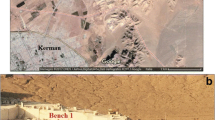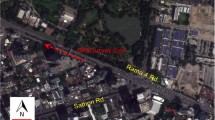Abstract
Ground penetrating radar (GPR) has been proven to be one of the most promising non-destructive methods that has been widely used in engineering quality inspections and condition assessments of underground structures. This paper reports an application study of GPR that presents a comprehensive survey of the auxiliary shaft of the Anli coal mine in China. During shaft installation, water gushing with a maximum inflow rate of approximately 16.0 m3/h occurred, and thus, it was urgent to determine the distribution range of anomalies and evaluate the lining thickness of the shaft to provide precise technical guidance for later treatments. A GPR grid scan was carried out by towing the antenna along 6 vertical measuring lines and 11 orthogonal circular measuring lines on the shaft surface. The GPR results show that the anomalies experienced by the shaft are voids, uncompacted areas and water bodies. Most anomalies were located in the outer shaft lining and surrounding soil. A vast majority of the shaft lining thickness reach its designed value, with a qualified rate of 91.2% for the inner shaft lining and 89.9% for the outer shaft lining, and the outer shaft lining exhibited inferior smoothness and uniformity. Under the guidance of the GPR results, a grouting treatment was carried out to water seal and strengthen the shaft lining, which, consequently, reduced the water inflow rate by 90%. The favourable grouting effect demonstrates that the GPR method can feasibly and successfully reflect the shaft lining and anomalies in shaft assessments. This engineering practice could serve as a case study reference for investigating any similar underground structure in the future.








Similar content being viewed by others
References
Abraham O, Dérobert X (2003) Non-destructive testing of fired tunnel walls: the Mont-Blanc Tunnel case study. NDT & Int 36:411–418
Alani A, Tosti F, Alani A, Tosti F (2018) GPR applications in structural detailing of a major tunnel using different frequency antenna systems. Constr Build Mater 158:1111–1122
Bosela PA, Lek-udom S, Mullangi S, Delatte N (2006) Field comparison of NDE methods for tunnel condition assessment. In: Forensic engineering, pp 620–640
Capozzoli L, Rizzo E (2017) Combined NDT techniques in civil engineering applications: laboratory and real test. Constr Build Mater 154:1139–1150
Daniels DJ (ed) (2004) Ground penetrating radar, 2nd edn. Institution of Engineering and Technology, London, pp 1–4. ISBN 978-0-86341-360-5
Deng X, Tian D, Quan Y, Xin Z (2015) Tunnel lining thickness and voids detection by GPR. Electron J Geotech Eng 20:2019–2030
Fernandes FM, Pais JC (2017) Laboratory observation of cracks in road pavements with GPR. Constr Build Mater 154:1130–1138
Gamayunova O, Gumerova E (2016) Solutions to the urban problems by using of underground space. Procedia Eng 165:1637–1642
GeoScience (2011) RAMAC/GPR CUII operating manual version 2.0. Mala GeoScience, Charleston, pp 6–11
Heincke B, Green AG et al (2005) Acquisition and processing strategies for 3D georadar surveying a region characterized by rugged topography. Geophysics 70:K53–K61
Inokuma A, Inano S (1996) Road tunnels in Japan: deterioration and countermeasures. Tunn Undergr Space Technol 11:305–309
Jeng Y, Chen CS (2012) Subsurface GPR imaging of a potential collapse area in urban environments. Eng Geol 147–148:57–67
Jing X, Zhang L, Yu Z (2007) Application of GPR technology in the quality detection of railway tunnel liner. Chin J Eng Geophys 4:345–349
Karlovsek J, Scheuermann A, Willimas DJ (2012) Investigation of voids and cavities in bored tunnels using GPR. In: 2012 14th international conference on ground penetrating radar (GPR)
Lai WWL, Chang RKW, Sham JFC (2018) A blind test of nondestructive underground void detection by ground penetrating radar (GPR). J Appl Geophys 149:10–17
Lalagüe A, Lebens MA, Hoff I, Grøv E (2016) Detection of rockfall on a tunnel concrete lining with ground-penetrating radar (GPR). Rock Mech Rock Eng 49:2811–2823
Li C, Li MJ, Zhao YG et al (2011) Layer recognition and thickness evaluation of tunnel lining based on ground penetrating radar measurements. J Appl Geophys 73:45–48
Maierhofer C (2003) Nondestructive evaluation of concrete infrastructure with ground penetrating radar. J Mater Civ Eng 15:287–297
Nakhkash M, Mahmood-Zadeh MR (2004) Water leak detection using ground penetrating radar. In Proceedings of 10th international conference on ground penetrating radar, Delft, Netherlands, pp 21–24
Nelson PP (2016) A framework for the future of urban underground engineering. Tunn Undergr Space Technol Inc Trenchless Technol Res 55:32–39
Pan D, Zhang H, Zhao X (2007) Application of ground radar to mine shaft liner grouting and result inspection. Coal Sci Technol 35:22–24
Qian Q, Lin P (2016) Safety risk management of underground engineering in China: progress, challenges and strategies. J Rock Mech Geotech Eng 8:423–442
Qian Z, Jiang Z, Guan Y, Yue N (2018) Mechanism and remediation of water and sand inrush induced in an inclined shaft by large-tonnage vehicles. Mine Water Environ 37:849–855
Rashed MA, Al-Garni MA (2013) On the application of GPR for locating underground utilities in urban areas. Arab J Geosci 6:3505–3511
Richards JA (1998) Inspection, maintenance and repair of tunnels: international lessons and practice. Tunn Undergr Space Technol 13:369–375
Sandmeier geophysical research (2019) Reflexw-GPR and seismic processing software. https://www.sandmeier-geo.de/reflexw.html/. Accessed April 2019
Shaw MR, Millard SG, Molyneaux TCK et al (2005) Location of steel reinforcement in concrete using ground penetrating radar and neural networks. NDT & E Int 38:203–212
Tao L, Wei G, Wei H, Shun Y, Kuai B, Guan C (2008) Application of GPR for cavity and loose region detection of shaft. Geotech Eng World 11:63–66
Thitimakorn T, Kampananon N, Jongjaiwanichkit N, Kupongsak S (2016) Subsurface void detection under the road surface using ground penetrating radar (GPR), a case study in the Bangkok metropolitan area, Thailand. Int J Geo-Eng 7:1–9
Xiang L, Zhou H et al (2013) GPR evaluation of the Damaoshan highway tunnel: a case study. NDT & E Int 59:68–76
Zhang H (2010) Application research of GPR technology in the governance project of the shaft wall in coal mine. In: Near-surface geophysics and geohazards—proceedings of the 4t international conference on environmental and engineering geophysics, vol 2. Chengdu, China, pp 656–660
Zhang J, Peng S (2005) Water inrush and environmental impact of shallow seam mining. Environ Geol 48(8):1068–1076
Zhang X, Jiang Y, Sugimoto S (2018) Seismic damage assessment of mountain tunnel: a case study on the Tawarayama tunnel due to the 2016 Kumamoto Earthquake. Tunn Undergr Space Technol 71:138–148
Acknowledgements
This research was supported by the Provincial Key Technological R& D Program of Henan of China [152102210318]; the National Natural Science Foundation of China [51778215] and the China Postdoctoral Science Foundation funded Project [2018M631114].
Author information
Authors and Affiliations
Corresponding author
Ethics declarations
Conflict of interest
The authors declare that there is no conflict of interest regarding the publication of this paper.
Additional information
Publisher's Note
Springer Nature remains neutral with regard to jurisdictional claims in published maps and institutional affiliations.
Rights and permissions
About this article
Cite this article
Guo, J., Zhu, B., Qian, Y. et al. Non-destructive Detection of the Anomalies and Thickness of a Shaft Using GPR. Geotech Geol Eng 38, 4435–4451 (2020). https://doi.org/10.1007/s10706-020-01300-x
Received:
Accepted:
Published:
Issue Date:
DOI: https://doi.org/10.1007/s10706-020-01300-x




